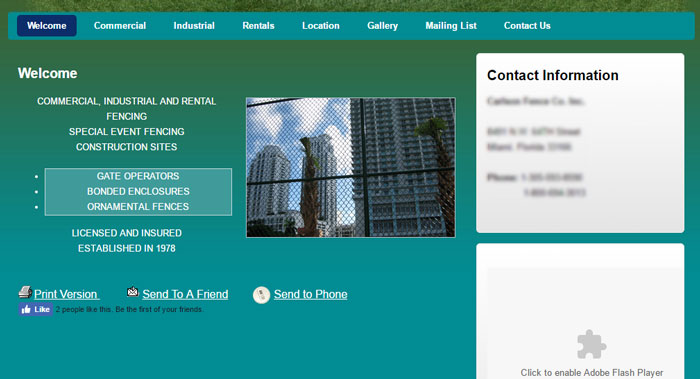We’ve all heard it countless times: “Don’t believe everything you read on the internet!” However, in healthcare, it’s a different story. 72% of consumers rely on the internet for healthcare information, so if you’re in healthcare, your website needs to be a credible source of information for your current and future patients!
In this blog we’ll talk about why having a credible website in the healthcare industry is important, and best practices for how to improve credibility with your website viewers.
Why having a credible healthcare website important
In healthcare, it is essential to have a trusting relationship between you and your patients. Without trust, optimal care couldn’t be achieved. The first place to build trust is your website as your site is usually the first impression future patients have with your healthcare business! They’ll likely base their opinion of your business based on what they see and read on your site before making the decision to trust you as a credible healthcare business or not.
To be a resource of information for patients and community members we recommend you follow these best practices to ensure your patients trust your research and opinions:
Website credibility best practices
Let’s start with the basics:
- Spelling: Make sure all words on your website are spelled correctly! Spelling errors can generate confusion among your readers and make your business appear less professional or reliable. Double-check, (triple-check even) to make sure there are no spelling or grammatical errors. You may want to use editing software like Grammarly or Hemingway to get some pointers for blog posts or case studies.
Here’s a quick list of the top 10 grammar mistakes we often see in business writing. - Author & date: On blog posts and other website content, include the author’s information and the date it was published. Having an author bio gives your readers an idea of who is behind the content, and if the author has impressive credentials you can gain even more credibility. Having the date your content was published visible also helps verify how recent the content is, so your readers can see how up-to-date your services are.
- Good design: In a study from Stanford’s Persuasive Technology Lab, 46% of respondents said that good design makes a website more credible. Provide an accessible website that is easy to navigate with minimal colors and an informative design to appeal to all audiences. Make sure your site is mobile responsive and performs well on all browser types too.
- Create a personable website: Having a personable website helps foster a trusting relationship between you and your patients. You can create a more personal healthcare website experience by including clear language, relatable imagery, and compliance best practices.
Being personable means making your content easily digestible, so stay away from any industry jargon when explaining topics, and instead include infographics or video marketing to keep your patients engaged. Being a credible healthcare site doesn’t mean flaunting all the big flashy words, it is about understanding your patients and proving you want the best for them.
A credible website is genuine and uses real-life imagery to demonstrate emotion and relatability. 33% of customers who leave their services suppliers say it’s due to the lack of a personalized approach.
A personable healthcare website is also an accessible one. For patients across the board, no matter how they are browsing your site it should be easy to use and resourceful for all viewers. Here are a few ADA and HIPAA compliance guidelines to follow:
• Optimal text size
• Close captions on videos
• Assistive technology
• Keyboard friendly
• Easy navigation
• Mobile responsive
The proof is in the pudding
You need to prove that you’re a reliable resource using your content! Use credible sources and statistics to back up any and all claims.
Below are some examples of content that prove you’re a credible and reliable source:
- Case studies:
Utilize case studies on your website to show real results from real patients. Share as much information as patients are comfortable with and describe matters in detail. Providing patients with an inside look into how your healthcare practice works will strengthen their confidence in your care.
- Before and after stories:
A picture is worth a thousand words, right? With before and after images, you can share real before and after results that help patients understand what to expect from you. The more real-life images you have, the more likely your patients will be able to relate! Keep in mind the patient is the priority when incorporating real-life pictures on your website. Anyone involved in these images should consent to the images being taken and be comfortable with their pictures on the website.
- Reviews and testimonials:
According to Software Advice, over 65% of patients use review sites before booking an appointment. Include reviews and testimonials throughout your website to demonstrate the connections you’ve made with previous patients. By showcasing previous patient’s experiences and the benefits they received from your care directly from the patient, your healthcare services are seen as more credible.
Example: Check out Cleveland Clinic’s Patient Stories page. They include a variety of patient testimonials with images of real people.
- Social Proof:
People are automatically more trusting in something if they see other people engaging positively with it. This is based on a theory called social proof, where people tend to adopt the opinions or actions of people they trust. To share some social proof and stimulate conversations make sure to share your achievements on your website. Whether it be award-winning care or recognition from the media, use your blog, social media pages, or even a dedicated award page, have your achievements in an accessible location for your patients to quickly and easily view.
Add activity trackers to your website and social media pages to get more people to share and comment. If patients see others sharing, commenting, and viewing, it builds social proof. This evidence makes your website feel more credible and community-centered as it suggests there are other website visitors who value your content.
Example: Paulding Hospital includes news, blogs, and awards they won on their homepage so their patients can see easily see and read about their publications.
Focus on educating your audience
It is important for your healthcare website to act as a resource for your patients and focus on the needs of your audience, rather than a marketing tool to attract new customers. Patient education is key to fostering a trusting relationship, as it shows you care about their understanding of the topic. Keeping an educational approach encourages your patients to make informed decisions based on their needs, making you and your team a credible source for their healthcare needs.
Here are a few best practices:
- Learn what your site’s users are looking for and incorporate those keywords into content, infographics, and blog posts.
- Make the information easy to digest, while staying relevant.
- Include a staff directory, with contact information and a simple bio for any of your staff. This helps future patients get to know your team and make informed decisions about their care. Don’t forget to keep all important contact information easily accessible on any page!
Incorporate key metrics and data
Use helpful statistics and data to back up your claims throughout your website content. The crucial element of true credibility is a well-researched blog, research article, or case study. Provide your patients with educational content with quantitative statistics and key data points to prove your knowledge on the subject.
Have there been any recent studies with your patients? Did your team show extreme growth in patients’ progress? Now is your time to showcase your experience and add credibility to your website.
Example: Check out Parsleyhealth’s website. Not only do they have a great design, but they also showcase statistics about their patients’ improved symptoms on their home page.
Statistics and metrics provide evidence of your expertise, and they show you have both the qualifications and the experience to prove yourself credible.
What not to do on your healthcare website
By now we know what we want to see on a credible healthcare website but what automatically reduces the credibility of your website?
A very busy design
75% of consumers judge credibility based on the design! Keep a clean organized design with your healthcare website branding. Make sure to keep advertisements separate from any healthcare content. You don’t want advertisements clogging up your page and making it confusing to read. Use minimal popups to keep from distracting the viewer. Don’t put out false promises on your website either. All of these busy elements distract your readers from your content.
An unprotected website
Don’t let your healthcare website go unprotected! Managing private information online is a big risk for patients, so make sure you have a protected server, and only allow login access to those with credentials.
Outdated design and content
According to a study conducted by the International Consumer Study, 75% of consumers assess the credibility of a business based on its website design. Current industry standards point to updating your website every 3-4 years. So even though your website from 2010 may still be functional and have great content, if it doesn’t measure up to today’s standard, it is likely to cause people to lose trust in your business and look for another competitor.
We see in this webpage, it provides the information we need, but is it visually appealing? When was the content last updated, and is it relevant today?

Here are a few other reasons to update your healthcare website design:
• It’s not mobile-responsive
• Difficult to navigate
• It’s not driving results
• Slow responding pages
• It’s not linked to your blogs or social media
Partner with Pyxl
Interested in more tips on how to improve your healthcare website? Check out our blog on the “8 Components Your Healthcare Website Needs.
Credibility is essential to a healthcare website. Your content needs to be as credible as your content says in order to avoid distrust. As a recap, include statistics and high-value data to back up your statements, create a personable and accessible website by keeping content clean and easy to understand, and include real patient case studies and patient testimonials to help build social proof that you’re a credible healthcare website.
Does your website need a credibility boost? Contact us! Throughout our 13 years of experience in building websites and writing content, we have continued to produce high-quality work, leading to many successful healthcare brands getting recognized as experts in their market. If you want to find out more, check out one of our healthcare case studies on Fillauer, a global prosthetic provider, to learn more about the work we can do for your business. Are you ready to build a credible healthcare website?

Updated: Jun 11, 2025
 Kati Terzinski
Kati Terzinski